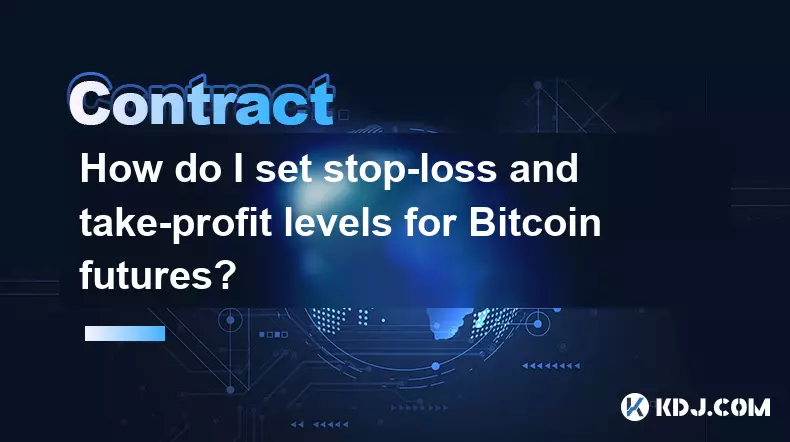-
 bitcoin
bitcoin $123963.239194 USD
1.37% -
 ethereum
ethereum $4529.082464 USD
1.07% -
 xrp
xrp $2.983640 USD
0.71% -
 tether
tether $1.000287 USD
0.02% -
 bnb
bnb $1179.874393 USD
2.99% -
 solana
solana $230.633678 USD
1.55% -
 usd-coin
usd-coin $0.999835 USD
0.03% -
 dogecoin
dogecoin $0.254240 USD
1.34% -
 tron
tron $0.341176 USD
0.15% -
 cardano
cardano $0.842285 USD
0.52% -
 hyperliquid
hyperliquid $48.537896 USD
-0.86% -
 chainlink
chainlink $21.863092 USD
-0.84% -
 ethena-usde
ethena-usde $0.999743 USD
-0.07% -
 sui
sui $3.579561 USD
-0.18% -
 stellar
stellar $0.403418 USD
2.67%
How do I set stop-loss and take-profit levels for Bitcoin futures?
Stop-loss and take-profit orders are vital for managing risk and locking in gains in volatile Bitcoin futures markets, helping traders avoid emotional decisions.
Oct 03, 2025 at 10:01 am

Understanding Stop-Loss and Take-Profit in Bitcoin Futures
1. Stop-loss and take-profit orders are essential tools for managing risk and securing gains when trading Bitcoin futures. These orders allow traders to automate their exit strategy, reducing emotional decision-making during volatile market movements.
2. A stop-loss order is triggered when the price reaches a specified level below the entry point for long positions or above for short positions. This helps limit potential losses if the market moves against the trader’s position.
3. A take-profit order closes the position when the price hits a predetermined target, locking in profits before a reversal occurs. Both orders are typically placed at the time of entering a trade.
4. In the context of Bitcoin futures, which often exhibit high volatility, setting these levels requires careful analysis of price action, support and resistance zones, and recent market behavior.
5. Traders should avoid placing stop-losses too close to the entry price, as normal market fluctuations can trigger premature exits. Similarly, overly ambitious take-profit targets may never be reached, causing missed opportunities.
Strategies for Setting Effective Levels
1. One widely used method involves identifying key technical levels on the chart. For example, placing a stop-loss just below a strong support level in a long trade ensures protection while allowing room for minor pullbacks.
2. The Average True Range (ATR) indicator can help determine an appropriate stop-loss distance. By measuring recent volatility, ATR allows traders to set dynamic stop-loss levels that adapt to current market conditions.
3. Risk-reward ratios are crucial when defining both stop-loss and take-profit points. A common approach is aiming for a 1:2 or 1:3 ratio, meaning the potential profit is at least twice or three times the potential loss.
4. Fibonacci retracement levels offer another technique. After a significant price move, traders use these levels to anticipate where reversals might occur, placing take-profits near resistance zones like the 61.8% or 78.6% levels.
5. Volume profile analysis helps identify areas with high trading activity. These zones often act as strong support or resistance, making them ideal reference points for setting protective and profit-taking orders.
Practical Tips for Execution
1. Always consider the funding rate and open interest in Bitcoin futures markets. High open interest near certain price levels can indicate where large positions are concentrated, influencing where stops and targets may cluster.
2. Use limit orders for take-profit execution to avoid slippage, especially in fast-moving markets. Market orders may fill at less favorable prices during sudden spikes or drops.
3. Traders must backtest their stop-loss and take-profit strategies using historical data to assess effectiveness under different market conditions.
4. Avoid placing stop-loss orders at round numbers like $60,000 or $65,000, as these are commonly targeted by liquidity hunters. Instead, use slightly offset values to reduce the chance of being stopped out by short-term manipulation.
5. Monitor liquidation heatmaps to understand where large stop-loss clusters might exist. This information can guide placement of personal orders away from heavily targeted zones.
Frequently Asked Questions
What is the difference between a stop-loss market order and a stop-limit order in Bitcoin futures?A stop-loss market order triggers a market sell or buy once the stop price is hit, ensuring execution but not price. A stop-limit order only executes at the specified limit price or better, offering price control but risking non-execution in fast markets.
Can I modify my stop-loss and take-profit levels after entering a trade?Yes, most futures exchanges allow traders to adjust or cancel stop-loss and take-profit orders anytime before they are triggered. This flexibility supports dynamic risk management based on evolving market conditions.
Should I use trailing stop-loss orders for Bitcoin futures?Trailing stop-loss orders can be effective in trending markets, as they automatically follow the price upward (for longs) or downward (for shorts), locking in profits while providing protection against reversals.
How does leverage affect stop-loss placement in Bitcoin futures?Higher leverage increases liquidation risk, requiring tighter stop-loss levels. However, overly tight stops may lead to early exits due to volatility. Balancing leverage with realistic stop distances is critical for sustained trading success.
Disclaimer:info@kdj.com
The information provided is not trading advice. kdj.com does not assume any responsibility for any investments made based on the information provided in this article. Cryptocurrencies are highly volatile and it is highly recommended that you invest with caution after thorough research!
If you believe that the content used on this website infringes your copyright, please contact us immediately (info@kdj.com) and we will delete it promptly.
- BlockDAG, DOGE, HYPE Sponsorship: Crypto Trends Shaping 2025
- 2025-10-01 00:25:13
- Deutsche Börse and Circle: A StableCoin Adoption Powerhouse in Europe
- 2025-10-01 00:25:13
- BlockDAG's Presale Buzz: Is It the Crypto to Watch in October 2025?
- 2025-10-01 00:30:13
- Bitcoin, Crypto, and IQ: When Genius Meets Digital Gold?
- 2025-10-01 00:30:13
- Stablecoins, American Innovation, and Wallet Tokens: The Next Frontier
- 2025-10-01 00:35:12
- NBU, Coins, and Crypto in Ukraine: A New Yorker's Take
- 2025-10-01 00:45:14
Related knowledge

What is the difference between futures and perpetual contracts for Bitcoin?
Oct 02,2025 at 11:54pm
Understanding Bitcoin Futures Contracts1. Bitcoin futures are derivative instruments that allow traders to speculate on the future price of Bitcoin at...

What is the best time to trade PEPE contracts?
Oct 03,2025 at 11:54am
Understanding PEPE Contract Volatility1. PEPE contracts exhibit extreme price fluctuations due to their meme-based nature and low market cap. Trading ...

What are the common mistakes to avoid with Bitcoincoin contracts?
Oct 03,2025 at 08:54am
Emerging Trends in the Cryptocurrency Market1. Decentralized finance (DeFi) platforms continue to expand their influence across the blockchain ecosyst...

What is the maintenance margin for Bitcoin contracts?
Oct 02,2025 at 01:36am
Decentralized Exchanges Gain Momentum in 20241. Decentralized exchanges (DEXs) have seen a significant rise in trading volume, surpassing centralized ...

How to use technical analysis for trading XRP contracts?
Oct 03,2025 at 01:18pm
Understanding Price Patterns in XRP Futures1. Identifying chart patterns such as triangles, head and shoulders, and double tops or bottoms can provide...

What does "longing" PEPE contracts mean?
Oct 03,2025 at 11:54pm
Understanding Decentralized Exchanges in the Crypto Ecosystem1. Decentralized exchanges (DEXs) operate without a central authority, allowing users to ...

What is the difference between futures and perpetual contracts for Bitcoin?
Oct 02,2025 at 11:54pm
Understanding Bitcoin Futures Contracts1. Bitcoin futures are derivative instruments that allow traders to speculate on the future price of Bitcoin at...

What is the best time to trade PEPE contracts?
Oct 03,2025 at 11:54am
Understanding PEPE Contract Volatility1. PEPE contracts exhibit extreme price fluctuations due to their meme-based nature and low market cap. Trading ...

What are the common mistakes to avoid with Bitcoincoin contracts?
Oct 03,2025 at 08:54am
Emerging Trends in the Cryptocurrency Market1. Decentralized finance (DeFi) platforms continue to expand their influence across the blockchain ecosyst...

What is the maintenance margin for Bitcoin contracts?
Oct 02,2025 at 01:36am
Decentralized Exchanges Gain Momentum in 20241. Decentralized exchanges (DEXs) have seen a significant rise in trading volume, surpassing centralized ...

How to use technical analysis for trading XRP contracts?
Oct 03,2025 at 01:18pm
Understanding Price Patterns in XRP Futures1. Identifying chart patterns such as triangles, head and shoulders, and double tops or bottoms can provide...

What does "longing" PEPE contracts mean?
Oct 03,2025 at 11:54pm
Understanding Decentralized Exchanges in the Crypto Ecosystem1. Decentralized exchanges (DEXs) operate without a central authority, allowing users to ...
See all articles










































































